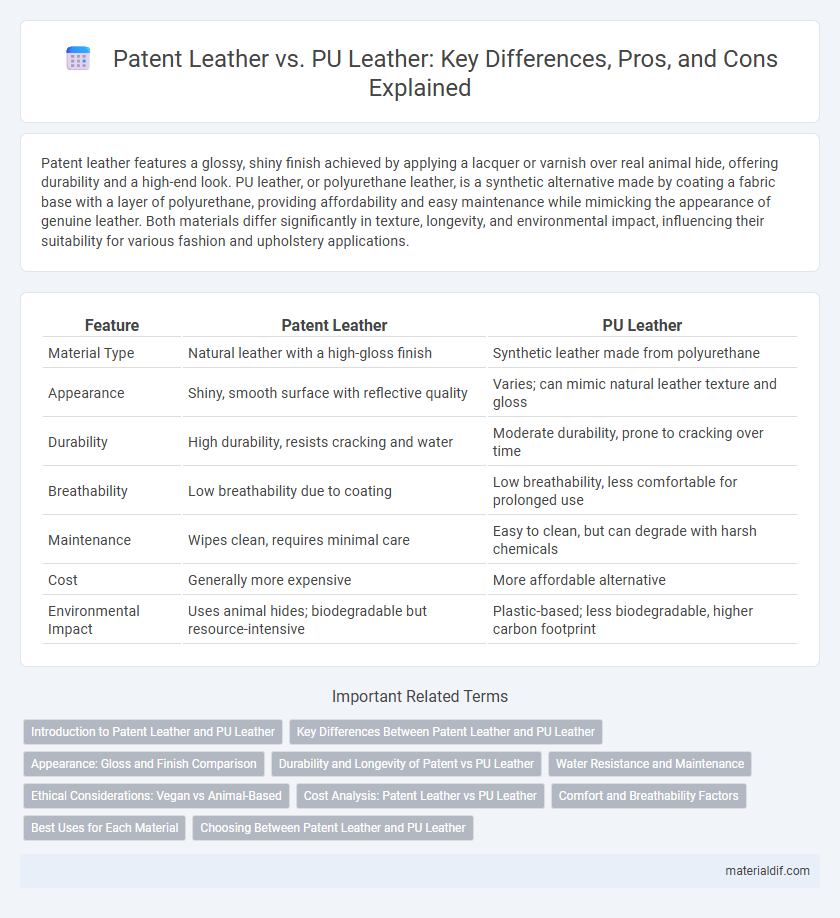Patent leather features a glossy, shiny finish achieved by applying a lacquer or varnish over real animal hide, offering durability and a high-end look. PU leather, or polyurethane leather, is a synthetic alternative made by coating a fabric base with a layer of polyurethane, providing affordability and easy maintenance while mimicking the appearance of genuine leather. Both materials differ significantly in texture, longevity, and environmental impact, influencing their suitability for various fashion and upholstery applications.
Table of Comparison
| Feature | Patent Leather | PU Leather |
|---|---|---|
| Material Type | Natural leather with a high-gloss finish | Synthetic leather made from polyurethane |
| Appearance | Shiny, smooth surface with reflective quality | Varies; can mimic natural leather texture and gloss |
| Durability | High durability, resists cracking and water | Moderate durability, prone to cracking over time |
| Breathability | Low breathability due to coating | Low breathability, less comfortable for prolonged use |
| Maintenance | Wipes clean, requires minimal care | Easy to clean, but can degrade with harsh chemicals |
| Cost | Generally more expensive | More affordable alternative |
| Environmental Impact | Uses animal hides; biodegradable but resource-intensive | Plastic-based; less biodegradable, higher carbon footprint |
Introduction to Patent Leather and PU Leather
Patent leather is a type of coated leather known for its high-gloss, mirror-like finish achieved through a lacquer or varnish coating on natural leather. PU leather, or polyurethane leather, is a synthetic material made by applying a polyurethane coating to a fabric base, designed to mimic the appearance and texture of genuine leather. Both materials are popular in fashion and upholstery due to their durability and aesthetic appeal, with patent leather offering a more polished look and PU leather providing versatility and affordability.
Key Differences Between Patent Leather and PU Leather
Patent leather features a glossy, high-shine finish achieved through a coating of lacquer or varnish on genuine leather, offering durability and a luxurious appearance. PU leather, or polyurethane leather, is a synthetic material created by applying a polyurethane coating to a fabric base, providing a more affordable, animal-friendly alternative with varied textures and lower maintenance. The key differences lie in their composition, finish, breathability, and overall feel--patent leather maintains natural leather properties beneath the glossy surface, whereas PU leather mimics leather's look without using animal hides.
Appearance: Gloss and Finish Comparison
Patent leather features a high-gloss, mirror-like finish achieved through a coating process that makes it shiny and smooth, ideal for formal footwear and accessories. PU leather, a synthetic alternative, offers a semi-glossy to matte finish with more texture variation, allowing for a broader range of stylistic options but less shine. The durable coating on patent leather resists scuffs more effectively than PU leather, which may show wear over time with a less reflective surface.
Durability and Longevity of Patent vs PU Leather
Patent leather is known for its high durability and glossy finish, achieved through a coating that makes it resistant to water and stains, ensuring long-lasting wear. PU leather, while more affordable and flexible, tends to wear out faster due to its synthetic coating that can crack and peel over time with frequent use. The longevity of patent leather generally surpasses PU leather, making it a preferred choice for products requiring sustained aesthetic appeal and resilience.
Water Resistance and Maintenance
Patent leather boasts superior water resistance due to its glossy, sealed surface that repels moisture effectively, making it easier to maintain in wet conditions. PU leather, although water-resistant to an extent, requires more frequent cleaning and protective treatments to prevent water damage and maintain its appearance. Maintaining patent leather involves simple wiping to remove dirt, while PU leather demands careful cleaning with mild solutions and avoidance of prolonged exposure to moisture.
Ethical Considerations: Vegan vs Animal-Based
Patent leather is derived from animal hides, raising ethical concerns related to animal welfare and environmental impact due to livestock farming. PU leather, a synthetic alternative made from polyurethane, offers a vegan-friendly option that avoids animal exploitation and reduces reliance on animal agriculture. Choosing PU leather supports cruelty-free fashion and aligns with growing consumer demand for sustainable, animal-free products.
Cost Analysis: Patent Leather vs PU Leather
Patent leather typically commands a higher price due to its glossy finish derived from natural leather coated with lacquer, involving more intensive manufacturing processes. PU leather, made from synthetic polyurethane, offers a more affordable alternative with lower production costs and greater versatility in texture and color. Consumers often choose PU leather for budget-friendly options while patent leather remains a premium choice reflecting quality and durability.
Comfort and Breathability Factors
Patent leather features a glossy finish that limits airflow, resulting in lower breathability and potential discomfort during extended wear. PU leather, made from synthetic materials, often offers greater flexibility and better moisture-wicking properties, enhancing overall comfort. When prioritizing breathability and prolonged comfort, PU leather tends to outperform patent leather due to its engineered ventilation and softer texture.
Best Uses for Each Material
Patent leather is ideal for formal footwear, handbags, and accessories due to its glossy finish and water-resistant properties, providing an elegant and polished look. PU leather, being more flexible and breathable, suits everyday items like jackets, upholstery, and budget-friendly bags, offering versatility and durability. Both materials cater to different needs: patent leather excels in style and shine, while PU leather prioritizes comfort and practicality.
Choosing Between Patent Leather and PU Leather
Patent leather offers a glossy, high-shine finish made by coating genuine leather with a lacquer, ensuring durability and a luxurious appearance. PU leather, a synthetic alternative crafted from polyurethane, provides flexibility, affordability, and ease of maintenance, making it ideal for budget-conscious consumers seeking vegan options. When choosing between patent leather and PU leather, consider factors like desired aesthetic, budget constraints, ethical preferences, and intended usage to select the most suitable material for fashion or upholstery needs.
Patent Leather vs PU Leather Infographic

 materialdif.com
materialdif.com